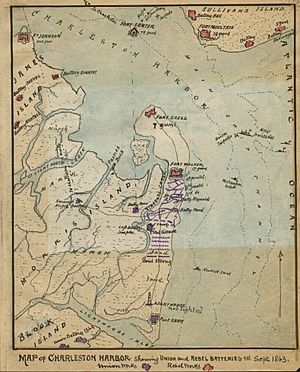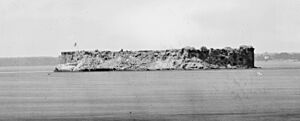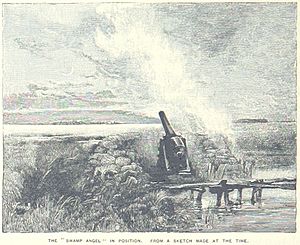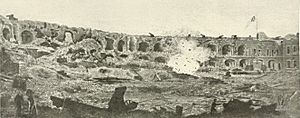Second Battle of Charleston Harbor facts for kids
Quick facts for kids Second Battle of Charleston Harbor(Siege of Charleston Harbor) |
|||||||
|---|---|---|---|---|---|---|---|
| Part of the American Civil War | |||||||
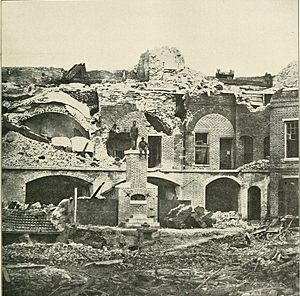 Photograph taken of eastern barracks and "hot Shot" cannon oven during the bombardment of Fort Sumter on September 8, 1863. |
|||||||
|
|||||||
| Belligerents | |||||||
| Commanders and leaders | |||||||
| Units involved | |||||||
|
|||||||
| Casualties and losses | |||||||
| 358 | 655 | ||||||
The Second Battle of Charleston Harbor was a major event during the American Civil War in 1863. It was also known as the siege of Charleston Harbor, the siege of Fort Wagner, or the Battle of Morris Island. This long fight involved the U.S. Army and Navy working together against the Confederate defenses of Charleston, South Carolina.
Contents
Why the Battle Happened
The Union Army, led by Major General Quincy Adams Gillmore, wanted to capture Fort Wagner. This fort was a strong Confederate defense on Morris Island near Charleston. After two failed attempts to storm the fort (meaning to attack it directly), General Gillmore decided to try a different plan. He chose to lay a siege to the fort instead. A siege is when an army surrounds a place and tries to capture it by cutting off supplies and constantly attacking it over a long time.
Who Was Fighting
The Union forces were led by Major General Quincy Adams Gillmore and Rear Admiral John A. Dahlgren. They had soldiers from the X Corps and ships from the South Atlantic Blockading Squadron.
The Confederate forces were led by General P. G. T. Beauregard and General Roswell S. Ripley. They defended Fort Wagner and Fort Sumter with soldiers from the Department of South Carolina, Georgia, and Florida.
The Siege Begins
New Ways of Fighting
| Main Commanders |
|---|
|
After the second direct attack on Fort Wagner failed, Union forces began their siege. They used some new military tools. One was the Requa gun, which had 25 rifle barrels on a single carriage. It could fire many shots at once.
Union engineers, called sappers, dug zig-zag trenches closer to Fort Wagner. They also used powerful calcium floodlights at night. These bright lights blinded the Confederate defenders, making it harder for them to shoot accurately. This allowed Union gunners to fire more safely.
Challenges for Both Sides
The ground on Morris Island was mostly shallow sand over mud. This made digging trenches very difficult for the Union soldiers. They even accidentally uncovered bodies from earlier battles.
Soldiers on both sides faced problems like disease and bad drinking water. These conditions made the siege even tougher for everyone involved.
Troops and Reinforcements
The Union army kept rotating soldiers in and out of the front-line trenches. This helped keep their troops fresh. However, a Confederate shell once hit a Union headquarters, wounding Colonel Joshua B. Howell. After this, the Union decided to use only experienced soldiers in the dangerous front trenches.
The Confederates also rotated their troops in Fort Wagner and Battery Gregg. Fresh soldiers would arrive by boat from the mainland at night. Both sides knew the fight would continue, so they needed to keep their forces strong. Union commanders, Gillmore and Dahlgren, even asked for more troops, and they received reinforcements from other Union armies.
Powerful Batteries

Even with the marshy ground, Union forces built strong artillery positions, called batteries, to fire at Fort Wagner. These batteries were often named after brave Union leaders.
Inside Fort Wagner, the Confederates had fewer powerful guns facing the land. They tried to use sharpshooters and their few land-facing guns to slow down the Union's digging. While they protected their own guns, they were still open to attacks from Union ships. They could only slow the Union advance, not stop it.
The "Swamp Angel" Cannon
On August 2, Union engineers began building a special battery further inland. Their goal was to bomb the city of Charleston directly. By August 17, a huge 200-pound Parrott rifle cannon was ready. It was nicknamed the "Swamp Angel."
On August 21, General Gillmore sent a message to General Beauregard. He demanded that the Confederates leave Forts Wagner and Sumter, or Charleston would be attacked. When Beauregard did not reply, the "Swamp Angel" fired its first shot into Charleston on August 22.
Confederate batteries tried to silence the "Swamp Angel," but they failed. Beauregard was angry that Gillmore was targeting a city with civilians. He asked for time to evacuate people. Gillmore agreed to a one-day ceasefire but also said Charleston was a military target because it supplied ammunition. Firing started again, but after 36 shots, the "Swamp Angel" cannon burst and could not be used again. This was one of the first times during the Civil War that a civilian city was directly targeted for military reasons.
Attacks on Fort Sumter
By mid-August, General Gillmore's siege guns were close enough to reach Fort Sumter. On August 17, Union forces began firing on Fort Sumter. On the first day, nearly 1,000 shells were fired. By August 23, the fort's stone walls were mostly rubble. Beauregard removed as many of the fort's guns as he could.
Gillmore sent a message saying, "Fort Sumter is a shapeless and harmless mass of ruin." However, Union forces continued to bombard Fort Sumter until the end of 1863.
The Fall of Fort Wagner
Fighting for the Rifle Pits
General Gillmore then focused his attention back on Fort Wagner. His troops were now close enough for infantry attacks. On August 21, Union soldiers tried to capture the Confederate rifle pits. These were trenches where soldiers could hide and fire. The Union troops briefly took control but were quickly pushed back by a Confederate counterattack.
The Confederates then worked to make their rifle pits stronger. But before they could finish, the Union Army attacked again. On August 25, Union soldiers, supported by the Requa guns, successfully captured the rifle pits. Many Confederate soldiers surrendered. The rifle pits then became a new Union siege line. On September 5, Gillmore and Admiral Dahlgren launched a very heavy bombing of Fort Wagner for 36 hours. This attack killed about 100 of the remaining Confederate defenders.
Confederates Leave Fort Wagner
Life inside Fort Wagner became very difficult for the Confederate soldiers. The fort's commander, Colonel Laurence M. Keitt, told General Beauregard that he had only about 400 men left who could still fight.
Because of this, on the night of September 6–7, Beauregard ordered his Confederate forces to leave Morris Island. On September 7, Union troops finally took control of Fort Wagner.
What Happened Next
Fort Wagner had been under constant attack for 60 days. It had held off a much larger Union army for a long time. However, the Union Army and Navy had captured an important position at the entrance to Charleston Harbor. They had also turned Fort Sumter into rubble.
Despite these Union victories, the city of Charleston and Fort Sumter itself remained under Confederate control. They would not be captured until William T. Sherman's Union armies marched through South Carolina in 1865.
Additional Maps
Gallery: Maps of the siege of Charleston Harbor from the Atlas to Accompany the Official Records of the Union and Confederate Armies.





